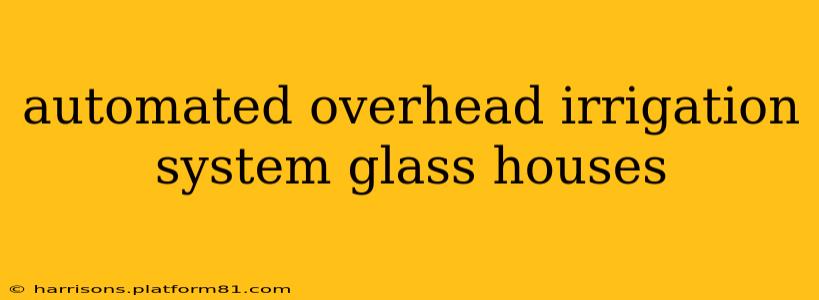Modern glasshouse cultivation relies heavily on efficient and precise irrigation systems to optimize plant growth and yield. Automated overhead irrigation systems are becoming increasingly popular, offering significant advantages over manual methods. This comprehensive guide explores the intricacies of these systems, addressing key aspects crucial for successful implementation and maximizing returns on investment.
What are the Benefits of Automated Overhead Irrigation in Glasshouses?
Automated overhead irrigation systems in glasshouses offer a multitude of benefits compared to manual watering. These include:
- Increased Efficiency: Automated systems deliver water precisely where and when it's needed, minimizing water waste and labor costs. Scheduling can be optimized based on environmental factors and plant needs.
- Improved Uniformity: Consistent water distribution ensures all plants receive the optimal amount of moisture, promoting even growth and reducing stress. This leads to more uniform yields.
- Enhanced Control: Automated systems allow for precise control over watering frequency, duration, and intensity. This flexibility is crucial for adapting to changing environmental conditions and plant growth stages.
- Reduced Labor Costs: Automation significantly reduces the time and labor required for irrigation, freeing up resources for other essential tasks.
- Optimized Resource Utilization: Precise water application minimizes water waste, contributing to sustainability and cost savings. Nutrient solutions can be efficiently delivered through the system.
- Improved Disease Control: Overhead irrigation can help prevent the buildup of pathogens in the soil by providing regular moisture without overwatering.
What are the Different Types of Automated Overhead Irrigation Systems for Glasshouses?
Several automated overhead irrigation system types are suitable for glasshouse environments. The best choice depends on factors like glasshouse size, crop type, budget, and desired level of automation.
- Drip Irrigation: While not strictly overhead, drip irrigation is often integrated into automated systems within glasshouses, delivering water directly to the plant's root zone, minimizing water loss through evaporation. This is particularly useful for certain crops and can be combined with overhead systems for humidity control.
- Micro-sprinklers: These low-pressure sprinklers provide gentle, localized watering, ideal for delicate seedlings and plants susceptible to damage from high-pressure sprays. They offer excellent water distribution uniformity.
- Rotating Sprinklers: These provide broader coverage and are more suitable for larger glasshouses. Different nozzle types allow for customization of water distribution patterns.
- Rain Bird Irrigation Systems (Example): Many reputable brands, including Rain Bird, offer comprehensive solutions, providing a variety of components and control systems for automated irrigation in glasshouses. They often integrate features like weather sensors and soil moisture monitoring for enhanced optimization.
How Much Does an Automated Overhead Irrigation System for a Glasshouse Cost?
The cost of an automated overhead irrigation system varies significantly depending on several factors:
- Size of the Glasshouse: Larger glasshouses naturally require more extensive systems, increasing the overall cost.
- Type of System: The complexity and features of the chosen system directly influence the price. More sophisticated systems with advanced control features and sensors will be more expensive.
- Components and Materials: The quality and type of components (e.g., sprinklers, pipes, controllers) affect the overall cost.
- Installation Costs: Labor costs for professional installation can be substantial, especially for larger and more complex systems.
It's crucial to obtain quotes from multiple suppliers and carefully consider all costs before committing to a specific system.
What are the Factors to Consider When Choosing an Automated Overhead Irrigation System for My Glasshouse?
Selecting the appropriate automated overhead irrigation system requires careful consideration of several key factors:
- Crop Type: Different crops have unique water requirements. The chosen system must match the specific needs of the plants being cultivated.
- Glasshouse Size and Layout: The size and layout of the glasshouse influence the design and configuration of the irrigation system.
- Budget: Establish a realistic budget that encompasses all costs, including equipment, installation, and ongoing maintenance.
- Water Source and Pressure: The available water source and pressure must be compatible with the chosen system.
- Climate and Environmental Conditions: The local climate and environmental conditions (e.g., temperature, humidity) influence the system's design and operation.
- Level of Automation: Consider the desired level of automation. Some systems offer more advanced features such as weather-based control and soil moisture monitoring.
How Do I Maintain an Automated Overhead Irrigation System?
Regular maintenance is crucial for ensuring the longevity and efficient operation of an automated overhead irrigation system. This includes:
- Regular Inspections: Inspect the system regularly for leaks, blockages, and damaged components.
- Cleaning: Clean sprinklers and filters regularly to prevent clogging and ensure uniform water distribution.
- Calibration: Calibrate the system periodically to maintain accurate water application.
- Software Updates (if applicable): Update the control software regularly to benefit from bug fixes and new features.
- Professional Maintenance: Consider scheduling professional maintenance checks to identify and address potential issues before they become significant problems.
By carefully considering these factors and implementing proper maintenance, growers can maximize the benefits of automated overhead irrigation systems, leading to improved yields, reduced costs, and a more sustainable cultivation process.
